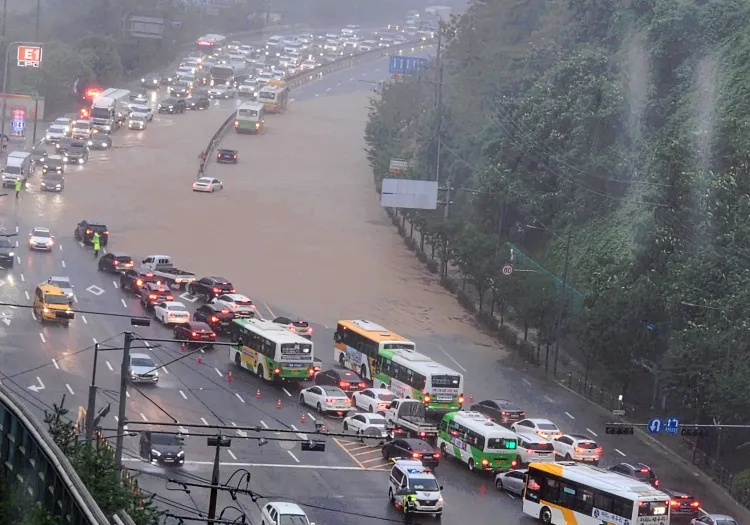What Caused the Torrential Rains in South Korea?

Synopsis
Key Takeaways
- Four fatalities reported due to torrential rains in South Korea.
- More than 5,600 individuals evacuated from their homes.
- Severe weather alerts issued across the nation.
- Government mobilizes all resources for disaster response.
- Search operations ongoing for missing persons.
Seoul, July 18 (NationPress) - Severe rainfall that impacted South Korea for three consecutive days has resulted in the tragic loss of four lives, with two individuals still unaccounted for, and more than 5,600 people forced to evacuate, authorities reported on Friday. The Korean Meteorological Administration has issued warnings for further heavy rainfall across the nation.
Some regions, particularly South Chungcheong Province and the southwestern city of Gwangju, experienced record-breaking hourly rainfall, which led to flash floods and landslides.
According to the government’s disaster response agency, the majority of rain-related fatalities have occurred in South Chungcheong Province. One victim was discovered in cardiac arrest inside a submerged vehicle on a road in Seosan. Despite being rushed to a nearby hospital, he did not survive.
An elderly man in his 80s was found deceased in his home’s basement, while a retaining wall collapse resulted in the death of a driver in a moving vehicle. Another victim was located in a stream.
A search operation is currently underway for a missing person in Gwangju, following a report around 10:18 p.m. on Thursday indicating that the individual had been swept away by river currents.
The region has endured over 400 millimeters of intense rainfall.
President Lee Jae Myung convened a disaster response meeting, urging all relevant ministries and agencies to utilize “every available resource” to mitigate damage. He stressed, “The state’s primary responsibility is to safeguard the lives and safety of its citizens.”
As of 11 a.m. Friday, authorities confirmed that 5,661 individuals from 13 cities and provinces have evacuated their homes due to safety hazards.
Reports indicate 499 public and 425 private property damage cases, with 328 instances of flooded roads and 30 cases of collapsed river embankments.
Two passenger ferry routes have been suspended, along with partial halts to train services on seven major lines, and a flight in Gwangju was canceled.
A total of 45 power outages were reported, with 36 restored by early Friday, while efforts to address the remaining nine are ongoing.
In response to the escalating situation, 247 schools nationwide have either suspended or shortened classes, or transitioned to online learning.
On Thursday, the government elevated the weather-related disaster alert to its highest category, “serious,” in light of the extensive damage caused by the ongoing heavy rains.
The emergency response system's highest stage has been activated, coordinating all relevant government ministries and agencies for comprehensive disaster management, as reported by Yonhap news agency.
Forecasts from the Korea Meteorological Administration predict an additional 100 to 200 mm of rain from Thursday to Friday for southern cities including Gwangju, Busan, and Ulsan, with some areas expected to receive over 300 mm. Additionally, 50 to 150 mm of rain is projected for the central Chungcheong area, North Jeolla Province, as well as Daegu and North Gyeongsang Province.









